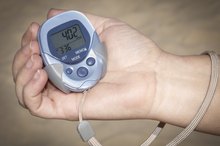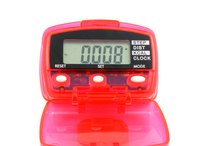Steps to Miles Conversion for a Pedometer
The general function of a pedometer is to count steps you take during a walk, run or jog. A pedometer can be useful in helping you reach specific exercise goals, including a daily walking goal. The American College of Sports Medicine classifies 10,000 steps per day as "active." It's easy to calculate how many miles per day your steps add up to.
Getting Started
In order to get accurate readings from your pedometer, first position it correctly and then test it for accuracy. The correct way to wear a pedometer is at your waistline, in line with the middle of your kneecap. However, you can attach the pedometer at your hip if your abdomen is large. Make sure your pedometer is parallel to the ground and not tilting one way or the other or you will not get a correct step reading. After correctly positioning your pedometer, the ACSM recommends testing it using a 20-step test. To do this, set the pedometer to zero, take 20 steps at your normal pace and then check to see if the pedometer reads between 18 and 22 steps. If it does not, reposition it and repeat the test until your pedometer gives an accurate reading.
- In order to get accurate readings from your pedometer, first position it correctly and then test it for accuracy.
Conversion Formula
How to Convert Steps to Calories Burned
Learn More
To convert walking steps to miles using a manual calculation, walk one lap around a 400-meter track, counting your steps as you go. Then, multiply your total steps by 4 to arrive at a steps-per-mile calculation. As an alternative, use the odometer in your car to drive and measure out 1 mile, and then walk the mile and count your total steps. Once you know your average steps per mile, you can calculate the number of miles you walk in a day by dividing total daily steps by average steps per mile. For example, if you count 500 steps on a 400-meter track, you walk at a rate of 2,000 steps per mile. If at the end of a day your pedometer reads 10,500 steps, you walked a total of 5.2 miles.
- To convert walking steps to miles using a manual calculation, walk one lap around a 400-meter track, counting your steps as you go.
Average Conversion
Another way to convert steps to miles is by using a step conversion chart. This can be useful to determine miles when you perform different types of activities and want to see how many miles they total. Texas Christian University provides estimates that include 2,000 steps per mile while walking or biking and 4,000 steps per mile while running, jogging or swimming.
Considerations
How to Determine Walking Speed
Learn More
To reach the 10,000-step recommendation of the ACSM, you need to walk about five miles per day. If your pedometer shows you are not reaching this goal, the ACSM suggests that each day you try to increase the number of steps you take by 1,000, or one-half mile. However, before starting a walking exercise program, the ACSM strongly suggests that you check with your doctor, especially if you have health concerns, are over age 40 or if you are new to exercise.
Related Articles
References
- North Dakota State University Extension Service: Walk ND
- Tudor-locke C, Craig CL, Brown WJ, et al. How many steps/day are enough? For adults. Int J Behav Nutr Phys Act. 2011;8:79. doi:10.1186/1479-5868-8-79
- Lee IM, Shiroma EJ, Kamada M, Bassett DR, Matthews CE, Buring JE. Association of step volume and intensity with all-cause mortality in older women. JAMA Intern Med. 2019;179(8):1105-1112. doi:10.1001/jamainternmed.2019.0899
- Cai X, Qiu SH, Yin H, et al. Pedometer intervention and weight loss in overweight and obese adults with Type 2 diabetes: A meta-analysis. Diabet Med. 2016;33(8):1035-44. doi:10.1111/dme.13104
- Hasan H, Attlee A, Jan bin jan mohamed H, Aris N, Bin wan muda WAM. Counting footsteps with a pedometer to improve HMW adiponectin and metabolic syndrome among young female adults in the United Arab Emirates. J Obes. 2018;2018:1597840. doi:10.1155/2018/1597840
- Salin K, Hirvensalo M, Magnussen CG, et al. Changes in daily steps and body mass index and waist to height ratio during four year follow-up in adults: Cardiovascular Risk in Young Finns Study. Int J Environ Res Public Health. 2017;14(9). doi:10.3390/ijerph14091015
- Yuenyongchaiwat K. Effects of 10,000 steps a day on physical and mental health in overweight participants in a community setting: A preliminary study. Braz J Phys Ther. 2016;20(4):367-73. doi:10.1590/bjpt-rbf.2014.0160
Writer Bio
Based in Green Bay, Wisc., Jackie Lohrey has been writing professionally since 2009. In addition to writing web content and training manuals for small business clients and nonprofit organizations, including ERA Realtors and the Bay Area Humane Society, Lohrey also works as a finance data analyst for a global business outsourcing company.









